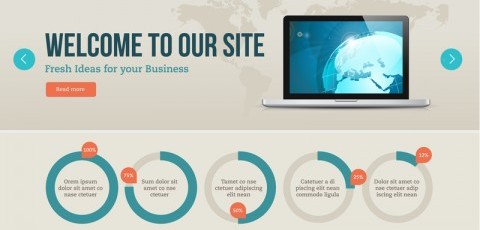Almost all businesses would benefit in some way from setting up a website – not only to sell products or services, but also to provide a brochure to potential clients or customers, or simply to provide contact information. So, how do you set up your own business website?

In fact, it has never been easier to create a website, and aside from creating a logo or extra design features, you can do everything without only a very basic knowledge of technology, or how the web works.
In the early days of the Internet, in order to create your own site, you would need to know how to use HMTL and Javascript code (as a minimum). These days, there are hundreds of online and offline software packages to help you create your own site in a short space of time, without having to get involved with the underlying code at all.
Here are the basic steps required to take your site from the ‘idea’ stage, to becoming a fully-functioning arm of your business:
1) Domain Names
All web sites have their own unique identifier – a domain name. Before you start, you should think carefully about what you want your domain name to be. Will it be your company / business name, a brand, or something else? And, is it actually available still? For UK-based companies, you should always ensure you can secure the .co.uk domain name, and if possible, the .com variant as well. There are dozens of other domain name sufficies on the market (from .tel to .co and .mobi), but unless you have a strong reason to invest in one of these, the .co.uk and .com should do very nicely.
Some of the leading domain name suppliers include Easily, 123-Reg, and Go Daddy. You register UK domain names for 2 years, and can secure .com domains for up to 10 years.
Of course, one of the other benefits of having your own domain name is that you can write emails using your own brand, i.e. jack@yourdomain.co.uk, which provides a far more professional image than jack@freeinternetprovider.uk.com.
2) Web Hosting
Your domain name then needs to be pointed towards your web space, which is hosted on a server somewhere in cyberspace. You can either secure a web hosting package from your domain name supplier, or a specialist firm (of which there are many). There are several types of web hosting available – shared hosting (where your site runs on a server with up to hundreds of others), dedicated hosting (your site(s) are the only ones on the server), or other variants such as virtual private servers (a more cost efficient alternative to dedicated hosting).
If you are just after a brochure site, or are running a small company operation, shared hosting should be sufficient. If, on the other hand, you are expecting a large number of visitors, or want to host more complex software online, then dedicated or VPS.
From our personal experience at Company Bug, we would recommend that you use a UK-based supplier, and look for a firm which has a good reputation for customer service and support. We have both VPS and shared hosting with Clook (including this one), and can recommend them highly to our visitors (there’s no commercial link between our sites).
3) Your Website
Once your web host has pointed your domain name to your web space, you will be able to upload your webpages. These days, we recommend you use a Content Management System (CMS) to manage your site. WordPress is the leading CMS platform in use on the web – it is a highly customisable piece of software, offering multiple themes, plugins, and support. It is also open source and free to use.
Chances are, unless you are running a design company, you will need some help creating the right look and feel for your company. Most designers work closely with the leading CMS’, including Drupal, Expression Engine, and Joomla.
Ask for recommendations from colleagues or contacts who have had their own sites built, or alternatively, you can post a project on an outsourcing site such as Odesk, Freelancer.com, or Elance.


Follow Company Bug